
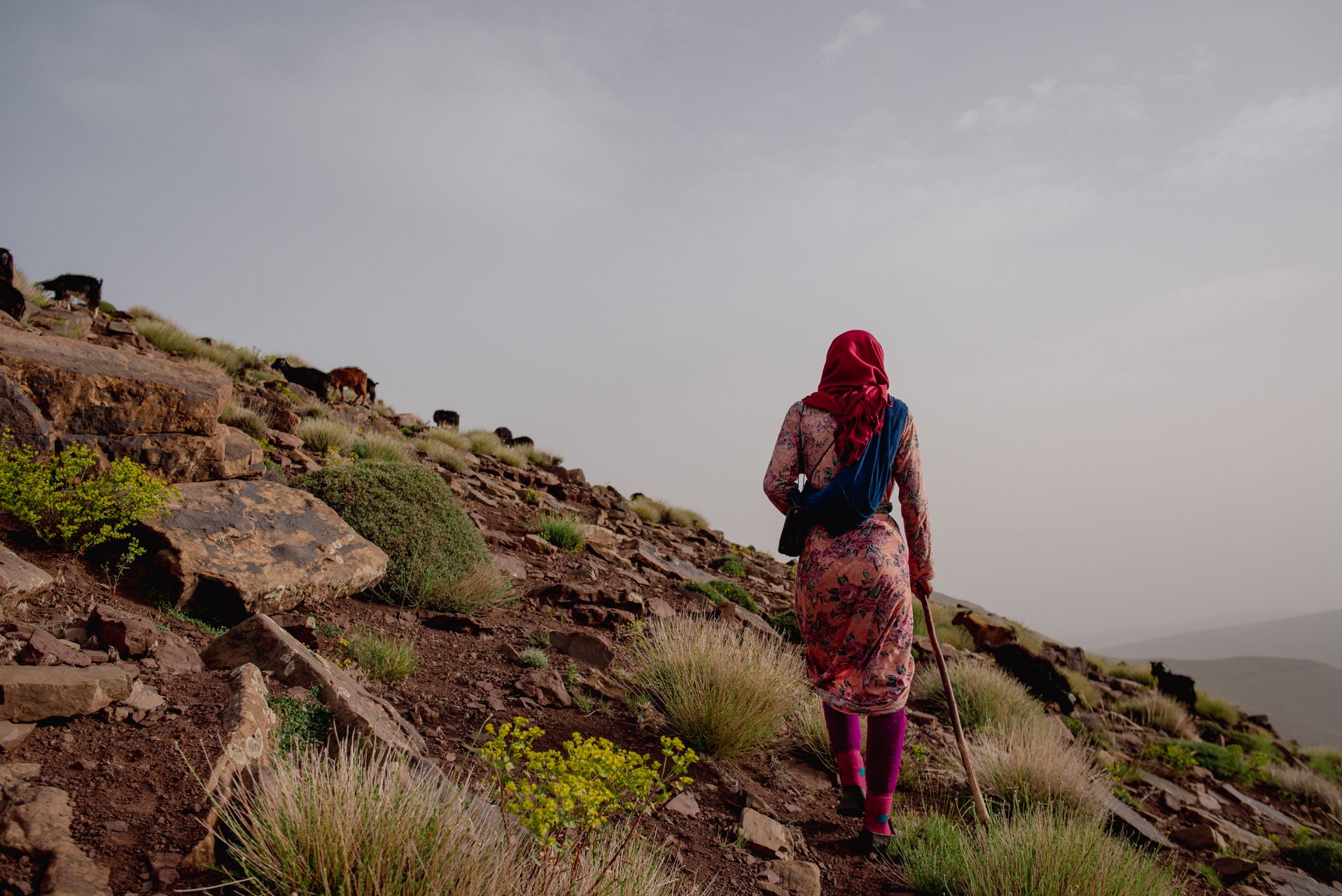
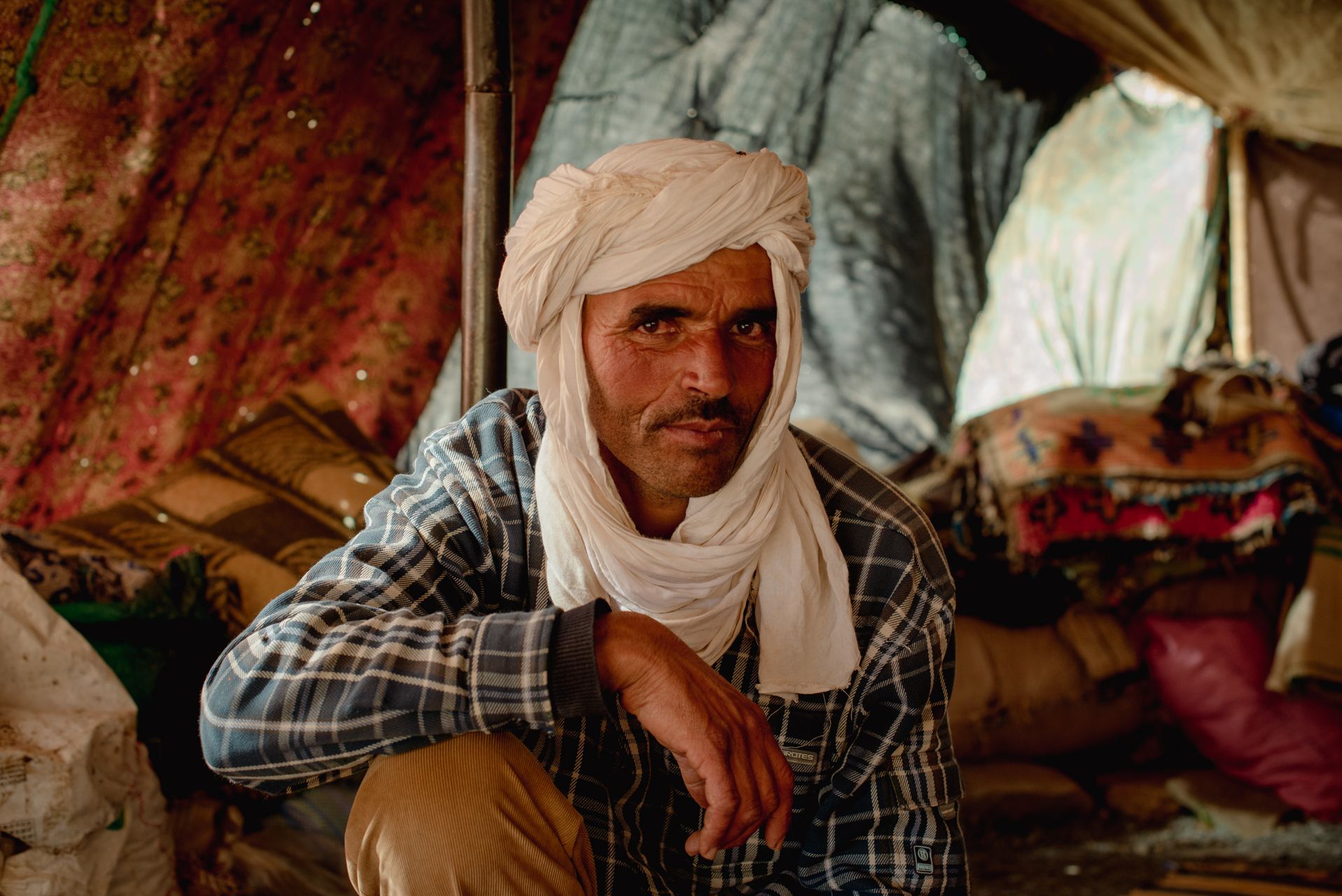
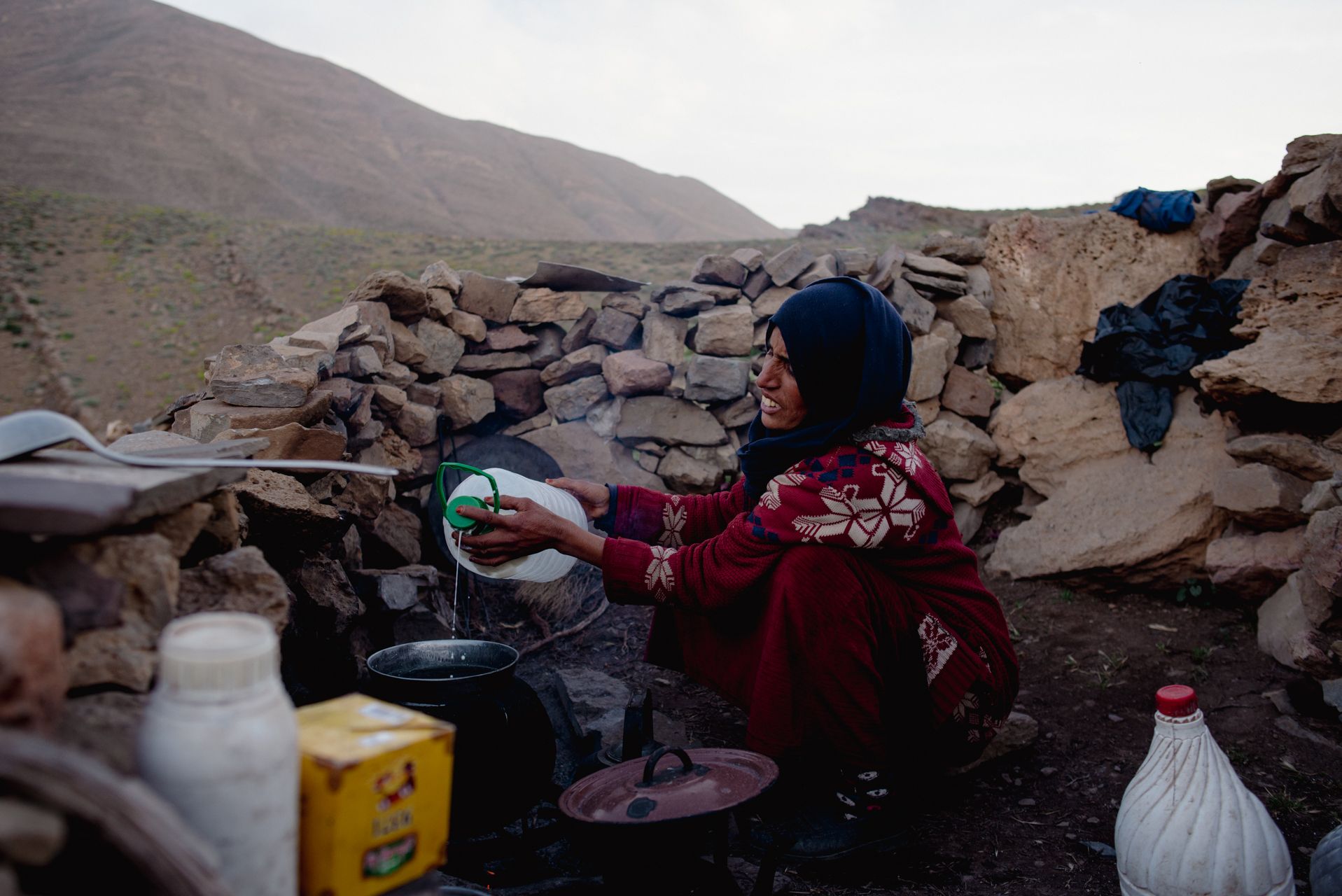
A Model for Land Management, Morocco’s Agdals Are at Risk of Disappearing
Seasonally managed indigenous lands provide a blueprint for responsible environmental stewardship, but the hardscrabble way of life is driving the practice to extinction
Listen to this story
A faint chill still hung in the air as the sun began its climb above the spine of Jbel Azourki, casting a warm glow over the shrub-studded slopes of Morocco’s High Atlas Mountains. The morning’s stillness was punctuated only by the Ben Youssef family folding blankets, stoking the fire and laying out breakfast. Five-year-old Siham was still asleep, a tuft of brown hair poking out from beneath a heavy, woolen blanket. “Siham, wake up!” her mother, Tlohou, called, placing a tray of tea and glasses in the tent’s center. As the rest of the family took turns dipping pieces of thick, chewy flatbread in fruity olive oil, washed down with sips of mint tea, Siham stirred, then flung the blanket off with a mischievous twinkle in her eye.
A few days before, the Ben Youssef family had arrived at the mountain highlands after setting out from Jbel Saghro in the Anti-Atlas, an arid mountain range in Morocco’s southeast. Following the Draa River, whose banks were lined with grass for their animals, the family would walk all day until finding a suitable place for their herd to rest. There, they would set up their tent, cook dinner and fall asleep, feet weary and limbs heavy. Upon waking the following day, they would eat breakfast, pack up everything on their camels and donkeys and begin the cycle all over again. After 15 grueling days, the Ben Youssefs reached Igourdane, a 12,000-acre communal pasture, known in Tamazight as an agdal, where their 400-some goats, handful of sheep, six camels, three donkeys and two chickens would spend the summer grazing.
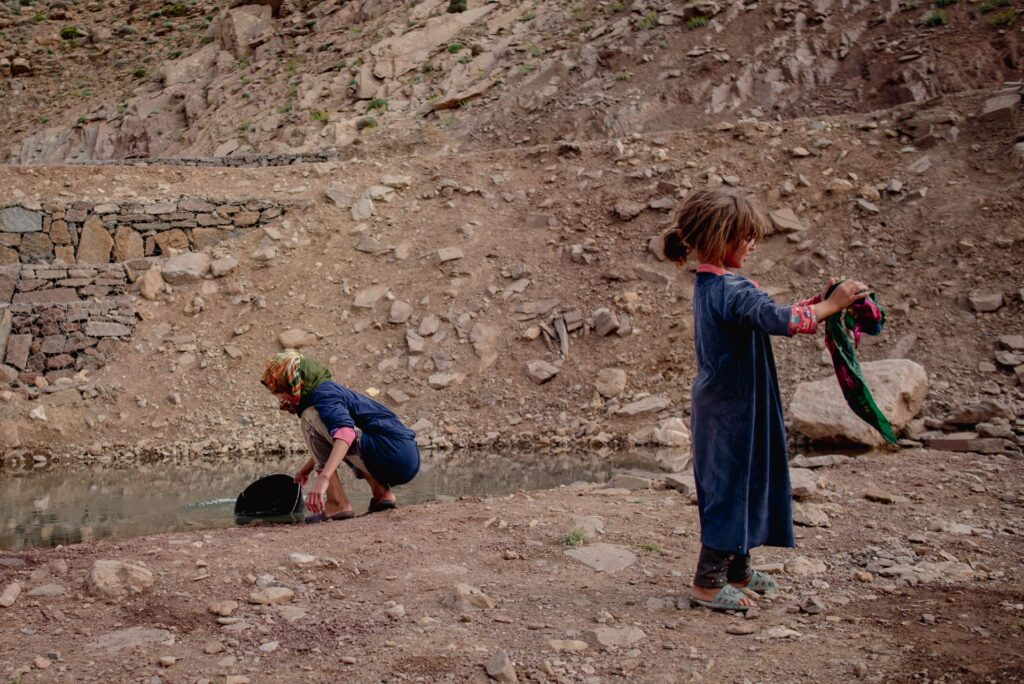
The word agdal is derived from a Tamazight root, meaning “to prohibit” or “to protect.” Agdals are found across the Maghreb — from the Atlantic coast of Morocco in the west to Tunisia in the east and from northern Algeria to the fringes of sub-Saharan Africa in the south — and refer to various systems of community resource governance. Igourdane is a pastoral agdal, used for pasturing livestock during specific periods throughout the year, but agdals can also take marine, forest, agricultural or even melliferous forms. It isn’t known exactly how old agdals are, but the presence of the word’s root across Tamazight-speaking areas supports the theory that agdals are as old as the arrival of the Amazigh into Africa, perhaps as long as 7,000 years ago, explains Pablo Dominguez, an environmental anthropologist and senior researcher at the French National Center for Scientific Research.
Located in the province of Azilal, the Igourdane agdal is shared between historic rights-holders from three tribes: Ait Mhamed, Ait Ali and Ait Atta, which the Ben Youssef family is a part of. During spring, a crucial moment of plant growth and reproduction, the agdal is closed and access to it is prohibited. The restriction ensures sustenance and survival for animals through times of scarcity and the regeneration of the mountain pastures for future use.
Every year for as long as they can remember, the Ben Youssef family has been making this migration, moving their livestock between the plains of the Anti-Atlas where they spend the winter and the pastures of the High Atlas where they pass the summer, a practice known as transhumance — from the Latin “trans” for across and “humus” for earth. Their movements maintain an age-old pastoral tradition, following seasonal cycles to take advantage of pastures at their peak and avoid extreme temperatures. It’s the only life the Ben Youssef family and their ancestors have known. But much has changed over the centuries. And now change has caught up with the Ben Youssef family, too.
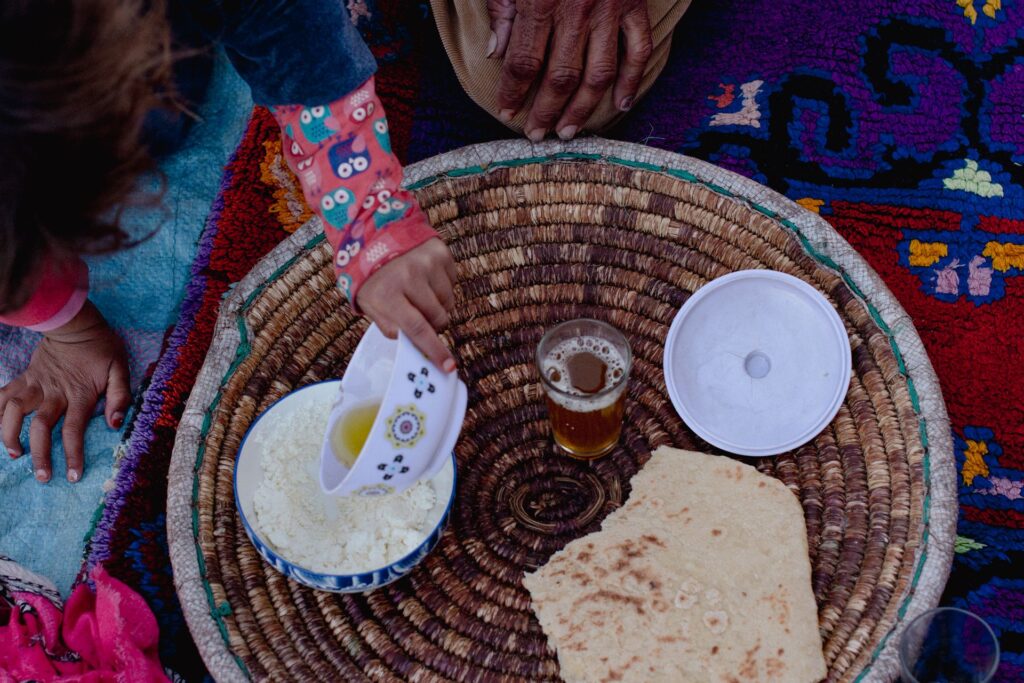
Being a transhumant pastoralist has never been easy, and in recent decades it has become only harder. Climate change is aggravating already harsh environmental conditions. Incomes, which depend directly on the quality and quantity of rain and grass, are as unpredictable as ever. And basic services and support from the Moroccan government are still lacking. Younger generations, unwilling to try to eke out a living from increasingly difficult circumstances, are abandoning transhumance. Parents, concerned about the future, are opting to send their children to school. Each year, fewer families are making the seasonal migration to the communal mountain pastures, breaking with an ancient and sustainable way of life that has characterized the High Atlas for centuries, if not millennia. The decline of transhumance is pushing pastoral agdals to the precipice at a time when scientists say sustainable land-use systems and the conservation of biodiversity are needed more than ever.
As global ecological collapse, known as the sixth mass extinction, worsens, Indigenous peoples and local communities’ governance systems and strong links with their territories stand out for contributing to the responsible and sustainable management of ecosystems. A growing number of studies in recent years have shown that most of the world’s remaining biodiversity is located on territories and areas like the Igourdane agdal that are governed, managed or conserved by Indigenous peoples and local communities. These areas — covering millions of square miles of land and seascapes worldwide, from the Amazon rainforest to the Arctic tundra to the Coral Triangle in the South Pacific, among many others — are thought to number in the hundreds of thousands and are increasingly recognized as key to the planet’s environmental sustainability, according to a 2023 global review. But despite their significant contributions to the conservation and sustainable use of biodiversity, these systems stewarded by Indigenous peoples and local communities are facing many threats and often suffer from a lack of recognition and support.
The difficulties of the transhumant lifestyle have long weighed heavily on Lahssen, Siham’s father and the household head. Wanting the best for his daughters, Lahssen decided several years ago to break with tradition and send them to school. The tensions the Ben Youssef family are experiencing are emblematic of a bigger struggle playing out across the High Atlas of Morocco: An ancient and sustainable way of life is rapidly vanishing, taking with it intangible cultural heritage and many ecological, social and economic benefits. But many people are no longer willing to live this way unless conditions improve.
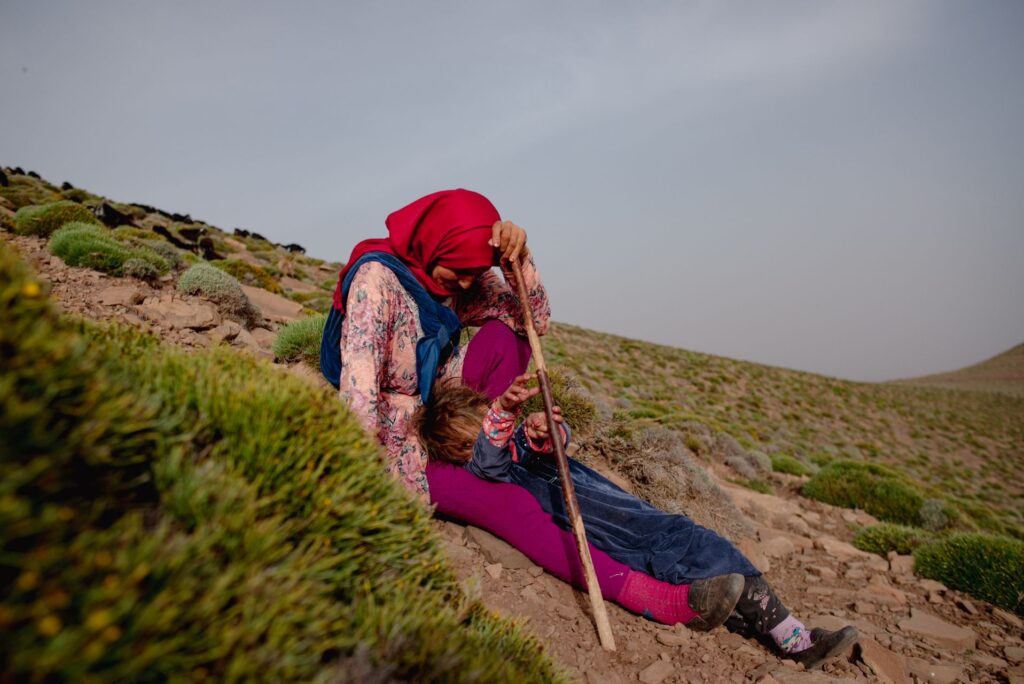
The breakdown of the agdal system threatens to further unravel the intricate web that sustains all life on earth. Over centuries, agdals have shaped the High Atlas landscape, maintaining the mountain pastures and conserving the area’s rich biodiversity. As transhumance is abandoned and agdals’ temporal grazing restrictions cease to be observed, the mountain pastures are at increased risk of overgrazing, which harms plant growth and reproduction, leading to dryland degradation and biodiversity loss. By chipping away at the ecological support systems that underpin human and societal needs, the loss of biodiversity ultimately imperils our survival. And once weakened by biodiversity loss, ecosystems, and all those who depend on them, are less resilient to our rapidly warming world, further endangering our future.
Tlohou was running late, and the goats were growing restless. Having packed dates, dried figs, bread and crumbly goat cheese in a blue-and-white striped cloth, she then filled a small plastic canteen with water and slung its strap over her shoulder. With the help of Izza, her eldest daughter, and with Siham in tow, Tlohou herded the goats up the hill behind the family’s camp, across the narrow dirt track cut into the hillside and onto the nearby slope. Mother and daughters moved quickly across the steep, rocky terrain, agile in their identical plastic slip-on shoes that cracked at the middle from wear. They wouldn’t return until dusk. In high summer, days in the pasture can be 13 or 14 hours long, the few juniper trees dotting the slopes offering little shelter from the sun, wind or occasional rain. In every direction, herds of sheep and goats speckled the slopes, their baas and bleats cutting through the silence of the mountains. About 80,000 head of livestock will traverse the slopes and valleys of Igourdane annually. In a good year, the Ben Youssef family will spend four months at the Igourdane agdal. In a bad year, when there isn’t enough grass to see the animals through September, they leave after three months.
In Morocco, pastoral agdals refer to both a place, like Igourdane, and a traditional land management system. As a place, these large tracts of land in the mountain highlands are typically abundant in water resources compared to their surrounding areas. They are often, though not always, in remote locations and are characterized by their lack of development and infrastructure, similar to national parks. As a system, agdals are collectively managed by several tribes or communities. Specific regulations on access rights, usually fixed opening and closing dates, are strongly based on Amazigh customary law, with traditional ways of enforcing them when violations occur, such as electing agdal guardians and payment of fines to the rest of the community — through, for example, cash, a lamb or butter. Activities like building, planting or cutting trees can also be forbidden within agdals. In some cases, particularly where there are fewer rights-holders and agreements are easier to reach, opening and closing dates are decided every year through communal decision-making processes, with the quantity of rainfall being a key determinant. In years with ample rainfall, agdals are opened later because grass remains in the lowlands further into the year. In years with little rainfall, less grass in the lowlands means pastoralists need to go to the highlands earlier for their animals to survive. As climate change reduces the amount of rainfall while making its timing more unpredictable, it’s “influencing the social decision-making processes of agdal openings, creating even stronger tensions,” Dominguez says. In other cases, such as in Igourdane, opening and closing dates were agreed on long ago and set in stone. As far as Lahssen knows, Igourdane has observed the same opening and closing dates since before the French colonized Morocco.
“These agreements are very hard to achieve,” says Dominguez. Once they are, “they’re supposed to be forever.”
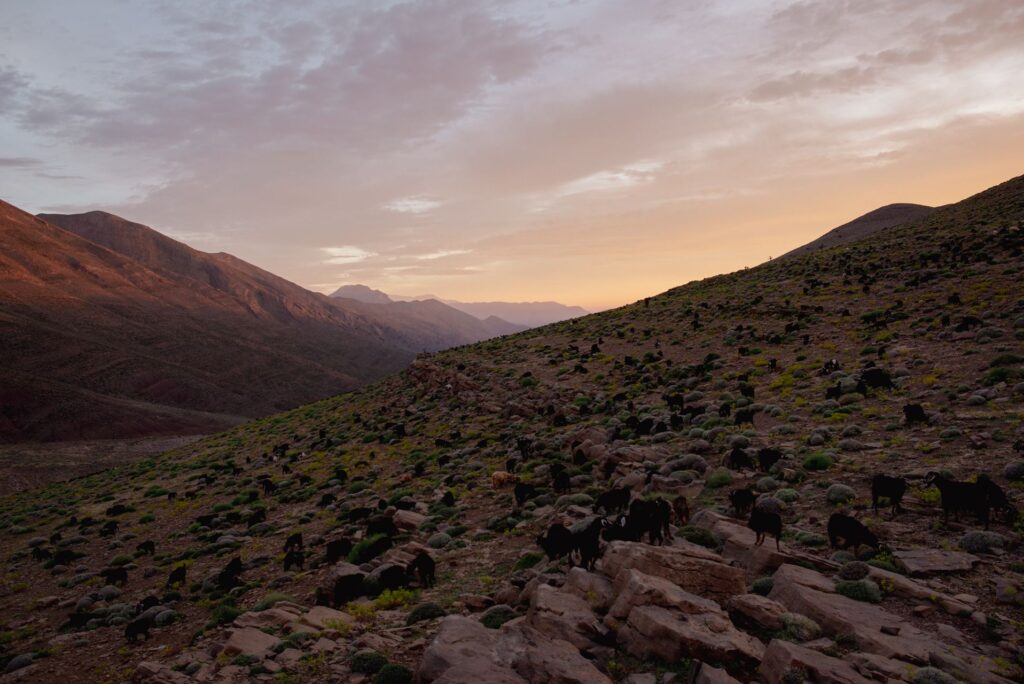
Pastoral agdals in the High Atlas are closed in spring, typically beginning in March or April, during which grazing is prohibited until they are opened from two to four months later. During their closure, the snow melts and the landscape comes alive in verdant green as plants begin to shoot up. The herding prohibition reduces grazing pressure at a key moment, maximizing plant growth and allowing plants to complete their full reproduction cycle. In turn, greater vegetation cover helps fight soil erosion, preventing dryland degradation, and provides a source of food for herbivores like wild sheep and gazelles. Research by the Global Diversity Foundation shows that biodiversity and vegetation cover, including endangered and endemic plants, are higher in agdals compared to areas where grazing prohibitions are not observed. Through traditional knowledge passed down over generations, pastoralists can read the ecological state of the pasture and know when it’s mature enough to go in or when it’s still too early. The agdal system allows transhumant pastoralists to get more from the land in a sustainable way and ensures a source of food for their livestock in times of critical need.
In principle, the agdal system serves as a form of redistribution by guaranteeing egalitarian access to all rights-holders. Communal decision-making about agdals is done through assemblies, where each household head has a vote. “No matter if you have five sheep, 50 or 500, everybody has the same say about a shared space,” Dominguez says. But, he adds, it’s not entirely democratic. It’s rare for younger generations within families, even those with their own herds of animals, to be able to participate or vote in the assemblies. Women are excluded from participating, despite their crucial role in upholding the transhumant lifestyle and agdal system. Debate may occur within households, allowing younger generations, and to a lesser extent women, to contribute and try to sway opinion. But in the end, only the household head, often a grandfather figure, is permitted to vote in the assemblies.
While in theory each household has one vote, some rights-holders try to pressure, influence or blackmail other rights-holders into voting in particular ways. At the same time, some breach the opening and closing dates, bending the rules to see what they can get away with, while others push for the abolishment of the grazing prohibition altogether. But overall, Dominguez says, there’s enough control to keep the system functioning. “Even if there are imperfections, what I’m seeing is that it works.” He cautions against idealizing agdals but says that by providing a respected and legitimate institution where people can speak, the agdal system can be understood as a social mechanism to manage conflict. That doesn’t mean it’s always peaceful. But without the agdal system, conflicts — including violent or even deadly ones — would be much worse.
The approach to managing conflict in the agdals has changed greatly over time. In the past, grazing prohibitions were sacralized, legitimized and supported by age-old beliefs and rituals associated with local Sufi saints, who were believed to be descendants of the Prophet Muhammad and imbued with “baraka” (God’s blessing). The saints helped maintain a fragile peace among as many as 100,000 people moving twice yearly with about 1 million animals between the lowland plains and the high mountain pastures. From the mid-20th century, a medley of influences, from Islamist movements to international tourism to the mass media, led to the devaluing of local cosmology, diminishing the role of the saints. In the course of his research, Dominguez found that a change in the effectiveness of the agdal prohibition was related to waning belief in the saints’ baraka and protection.
These days, if there’s a conflict that tribes cannot solve themselves, a representative from the Ministry of the Interior steps in to help reach the best agreement possible — a move that some say opens the door to greater corruption, because it’s easier to buy off one police officer than an entire tribe or tribal confederation, says Dominguez. Infractions are sometimes solved internally, but when they’re not, or if they’re more serious, they’re typically taken to the police in the lowlands, creating a hybrid system in which Amazigh customary law and the law of the Moroccan state cohabitate.
As the evening light softened and the shadows grew longer, Izza marched into the camp, hunched over beneath a bundle of twisted shrubs. Siham, a few moments behind her, bounded down the hill, stopping to pet the donkeys. Panting, Izza let the bundle fall from her slender frame to the ground. When she is not needed to help with the animals — two people must always watch over them — Izza’s days are marked by tasks that sustain her family’s day-to-day life: gathering firewood, collecting water for drinking and cooking, and washing their clothes. Somewhere in her early teens, Izza has never attended school. The seminomadic lifestyle of transhumant families makes it complicated to educate their children — if they desire to. Izza wanted to go to school. But when the time came for her to begin, no family members were able to take care of her year-round in the family’s home village, where she would have studied. She grew up quickly as she continued to live on the move with her parents, aunt and grandfather, watching over the years as one by one her three younger sisters went on to have an opportunity that life, by a twist of fate, denied her. At the end of this summer, it will be Siham’s turn to start studying.
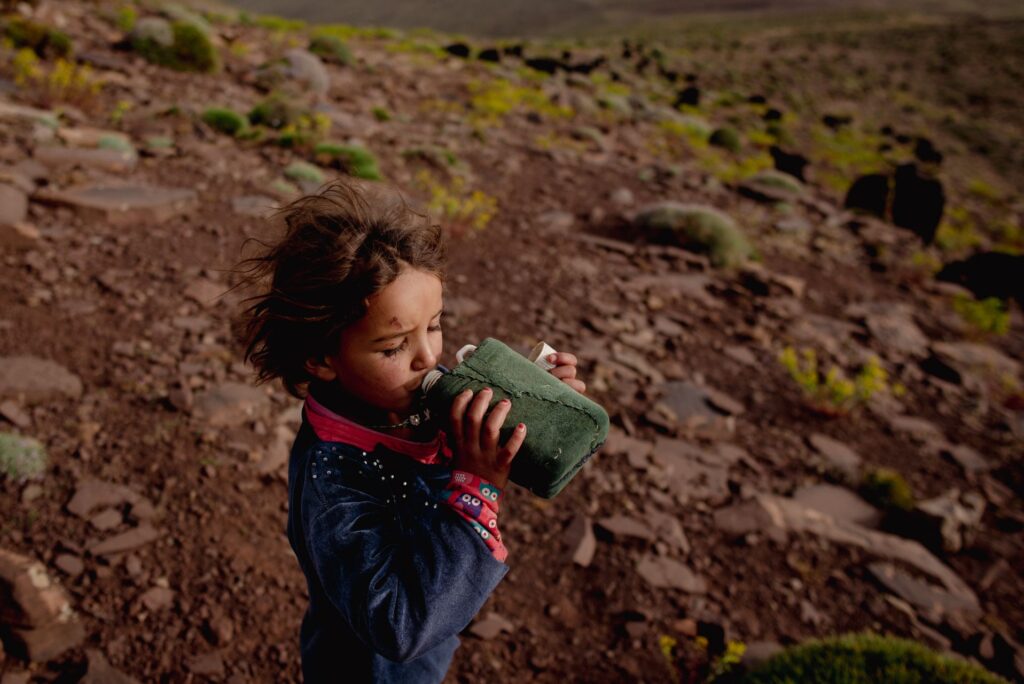
Dealing with hardship and uncertainty is intrinsic to life as a transhumant pastoralist. But for some families, the increasing difficulties of recent decades are too much to bear. The harsh and highly variable environmental conditions that they must already cope with are being exacerbated by climate change. Droughts are increasing in frequency and intensity, a trend that is expected to worsen. In Lahssen’s experience, Igourdane has been less affected compared to the pastoral lands where they spend the winter. Last year, they had to supplement with feed during the coldest months, otherwise their animals wouldn’t have survived. But in general, he says, the weather is changing everywhere and becoming more erratic. In winter, when they need it, they don’t get rain. And in summer, when they don’t need it, it rains.
“The weather can be a kind of enemy,” he says.
Pastoralists’ incomes, which are influenced by rainfall, are highly unpredictable, further riddling their lives with insecurity. More rain means more grass. More grass means animals eat better. Healthier, fatter animals produce more babies and sell for higher prices.
“One year you can win a lot and the next lose half your animals or worse,” says Dominguez. “It’s very hard to capitalize and accumulate wealth with such devastating uncertainty.”
Beyond the environment, a number of other forces are contributing to the decline of agdals, says Ugo D’Ambrosio, a scientific and technical adviser at the Global Diversity Foundation, which works on biodiversity conservation and livelihoods in the High Atlas. Traditional livestock breeds that are well adapted to the harsh climate are being crowded out by breeds that produce more meat and milk but are not well adapted. Pests can wipe out entire herds, causing families to lose a lot of money, if not almost everything. “Nomadic life can go very well one year and can go terribly bad another year,” D’Ambrosio says. Plus, he adds, there’s no pension when you retire from transhumance. “Even if you worked really hard all your life, when you’re 75 or 80 you have nothing accumulated. Now, people want comfortable lives with a more secure income.”
The immense difficulties and lack of support from the Moroccan government are leading families to abandon transhumance. In 1984, 100 families from the Ait Atta tribe made the seasonal migration to Igourdane, according to the Global Diversity Foundation. By 2019, they found only 10 did so. This year, Lahssen says only seven or eight families from Ait Atta came to Igourdane. Some families turn to farming, others keep their animals but remain in the same place, while others walk away from rural life altogether. As fewer families undertake the transhumance to the mountain pastures every year, an ancient form of communal governance is breaking down.
The rapid decline of the agdal system follows a broader trend challenging common property regimes, often referred to as commons, underway since the 20th century. The ecologist Garrett Hardin’s 1968 article “The Tragedy of the Commons,” which posited that sharing pastures led to overgrazing and advocated private land ownership, was particularly damaging, even though it mistakenly conflated common property with free open access. In the decades since, considerable research has disproved the “tragedy of the commons” assumption. Yet commons around the world still lack recognition, despite scientists, international agencies, nongovernmental and grassroots organizations alike increasingly recognizing they are critical to the future of a healthy and sustainable planet.
Over the years, pastoral agdals in Morocco have existed in an unofficial space that simultaneously leaves them alone and at risk. Although the Moroccan government is aware the country’s many agdals are important for the economy and sustainability of the mountains, they typically lack explicit government recognition and support, says Dominguez, adding that an unwritten policy has been to let the Amazigh tribes be, so long as there are no problems and the tribes or the agdals don’t run up against the state’s interests. Dominguez says the state will defend agdals, “but just as long as they don’t find better business to do with them.”
In 2016, the Moroccan government passed a law on pastoral transhumance and the development and management of pastoral spaces. But agdals are still falling through the cracks. “Up to now, many agdals are not recognized,” concedes Ahmed Ramdane, a government official responsible for livestock and range management. “Agdals must be recognized in the future as protected areas, or as a space that is managed by local people using local knowledge. It is a practice we have to encourage, to maintain in these spaces,” says Ramdane. But for many families, these efforts may be too late.
Lahssen stared into the distance as he recalled how, when he was a child, going to school was less important than it is today. Still, he said, he wishes he had learned to read and write. He knows all too well how hard it can be to leave this way of life when you’re born into it. He dropped his gaze to the ground as he explained why his eldest daughter didn’t get the opportunity to study; he wishes things could have been different. But he thinks it’s too late for her to start now. Plus, he points out, her support of the family and help with the animals is invaluable. Yet he understands their way of life is especially hard on girls and women, and he yearns for a different future for his daughters.
“I want them to get married and have a good life,” he says quietly. Although Lahssen can’t imagine what will happen — to the family, to the agdal system — as his daughters, like many other children, leave transhumance, he thinks school is an important step toward whatever the future may hold.
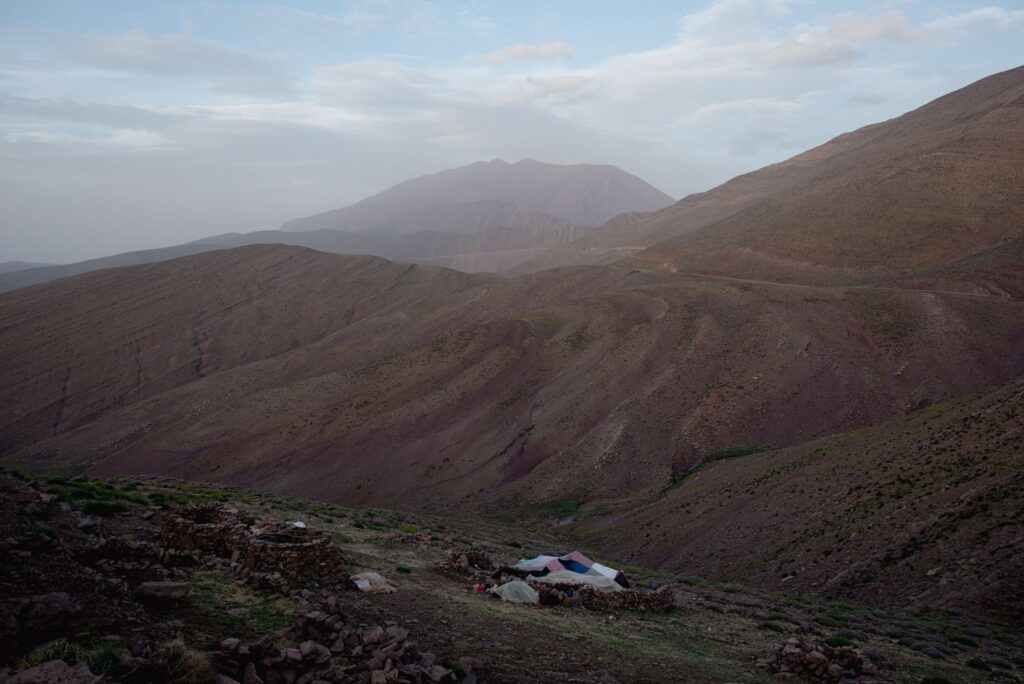
Youths abandoning the transhumant lifestyle in search of education is one of the main reasons agdals are in crisis, says D’Ambrosio. “It’s very difficult to educate your children if you’re a nomadic person, so your children won’t have opportunities of finding other kinds of livelihoods. This is why most children now are not accompanying the parents,” he says. “And then there is a breakage. This is a big crisis. If you don’t transmit it to the younger generations, it will be done.”
Soufiane M’Sou, regional director of the central High Atlas program for the Moroccan Biodiversity and Livelihoods Association, says that while the government is providing some support, more is needed in order for transhumant families to maintain their lifestyle and the agdal system. Providing mobile schools in agdals is one example, says M’Sou, which would prevent families from being split up for long periods at a time and allow children to choose the lifestyle they want later on.
Scientists, nongovernmental organizations and government officials are adamant about the importance of preserving agdals because of their myriad environmental, social and economic benefits when adequately governed. But for the people actually upholding the agdal system, those benefits matter little as they live without comforts and conveniences, weathering crises and change, uncertainty their only guarantee as conditions become harsher.
“With small things, you can do a lot. But the state does nothing,” Dominguez says. “I think Morocco is not fully conscious of the jewel it has.” The agdal system is declining rapidly before our collective eyes and cannot survive with the current approach. It is urgent, Dominguez stresses, for the government to pass legislation to protect agdals and implement policies to actively support them.
Ramdane says the Moroccan government has several social and environmental interventions planned or already being implemented to address these and other points as part of its Green Generation Strategy 2020-2030, which aims to develop and modernize the country’s agricultural sector. According to Ramdane, the government has already started providing mobile schools for transhumant students in some, though not all, areas. Other measures they are rolling out include building water infrastructure and shelters for animals in mountain pastures, vaccinating sheep, goats and camels to protect them from diseases, restoring vegetation in agdals and other pastoral areas, subsidizing animal feed in drought years and improving mobile health care services in remote areas, including agdals, where people otherwise struggle to access it.
Whether the support arrives in time or is sufficient remains to be seen. Ramdane admits that there’s a risk that the agdal system will continue to disappear from some areas. But in other areas, he thinks the planned interventions will allow it to continue.
Having survived manifold political, economic and environmental changes through the centuries, agdals demonstrate the resilience inherent in the system, says D’Ambrosio. And that resilience can help people to cope with the challenges of the future.
“Commons offer the opportunity to maintain these unique biocultural landscapes while we continue to adapt to global change,” he says.
The late afternoon sun beat down on Izza and Siham as they soaked and scrubbed clothes near a small water source about a mile away from their family’s camp. Their donkeys had followed them there and grazed and chased each other in turns. On the slope below, two women idled away the hours chatting as their family’s flock of sheep nibbled the emerald pasture. After wringing the sopping clothes with as much strength as their young hands could muster, the girls laid each piece to dry on large, flat rocks. When they made it through the pile, Izza shoved the clothes in a pink, orange and yellow checkered backpack. Before she could hoist it over her shoulder, Siham tried to grab the bag. But Izza objected. The bag is her burden to carry. In a few months, the girls’ lives will move in different directions, possibly forever: one in the footsteps of the generations that came before her, an endless dance between the mountains and the plains, the other into a new world — of letters and numbers and classmates, of unimagined possibilities. But for now, they are still two young girls, sisters, giggling and shrieking as they race each other home.
This reporting was supported by the International Women’s Media Foundation’s Howard G. Buffett Fund for Women Journalists.
This article was published in the Fall 2023 issue of New Lines’ print edition.
Become a member today to receive access to all our paywalled essays and the best of New Lines delivered to your inbox through our newsletters.


